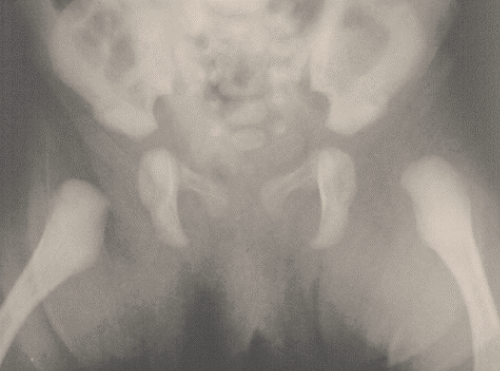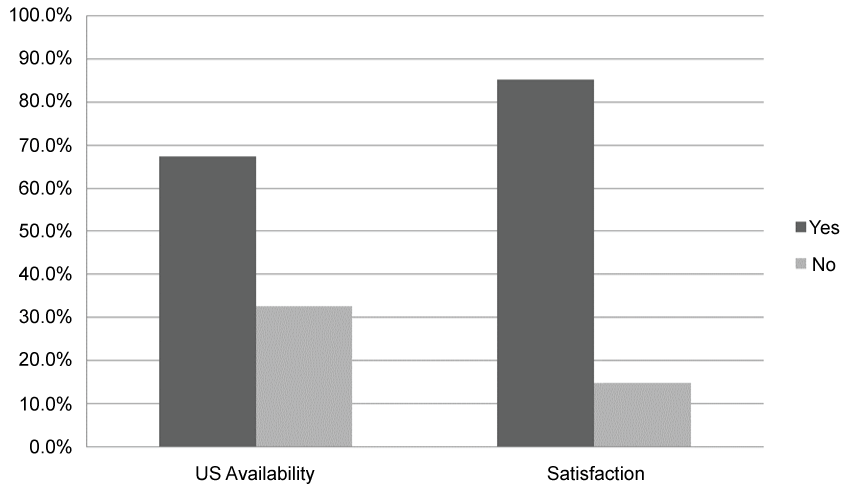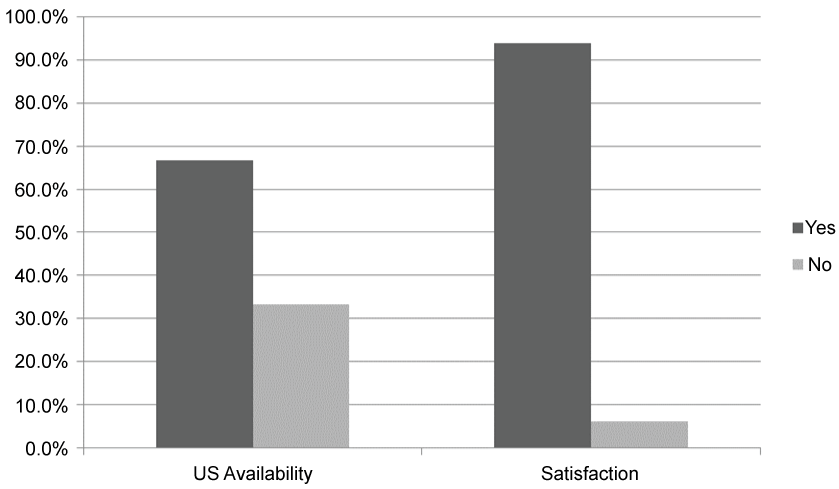Journal of Family Medicine and Disease Prevention
The Availability of Ultrasound for Infants with Developmental Dysplasia of the Hip in Pennsylvania
Shane Lavin* and William Hennrikus
Department of Orthopedics, Penn State College of Medicine, USA
*Corresponding author: Shane Lavin MD, Department of Orthopedics, Penn State College of Medicine, 30 Hope Drive, Hershey PA, 17033, USA, Tel: 724-787-3100, E-mail: shanelavin21@gmail.com
J Fam Med Dis Prev, JFMDP-1-012, (Volume 1, Issue 3), Original Research; ISSN: 2469-5793
Received: June 24, 2015 | Accepted: October 10, 2015 | Published: October 13, 2015
Citation: Lavin S, Hennrikus W (2015) The Availability of Ultrasound for Infants with Developmental Dysplasia of the Hip in Pennsylvania. J Fam Med Dis Prev 1:012. 10.23937/2469-5793/1510012
Copyright: © 2015 Lavin S, et al. This is an open-access article distributed under the terms of the Creative Commons Attribution License, which permits unrestricted use, distribution, and reproduction in any medium, provided the original author and source are credited.
Abstract
Purpose: The American Academy of Pediatrics (AAP) guidelines recommend an ultrasound exam for all female infants born in breech position. The purpose of this paper is to determine the availability of U.S. for examining infants for developmental dysplasia of the hip (DDH) in the state of Pennsylvania (PA).
Methods: A questionnaire was mailed to 744 members of the PA chapter of the American Academy of Pediatrics and to 100 Pennsylvania hospital radiology department directors, and results statistically analyzed.
Results: 15% of pediatricians and 24% of radiologists returned a completed questionnaire. Only 67% of pediatricians had access to U.S. at their hospital for infants with possible DDH. Of those with access, 85% were satisfied with the U.S. service that was available. When U.S. was not available locally, 86% of pediatricians sent their patients to another hospital for the U.S. study at an average distance of 30 miles and a range up to 130 miles. Fourteen percent of pediatricians utilized radiographs when U.S. was not available. 67% of the radiology directors provided U.S. for infants with DDH. 94% were satisfied with their service. 33% of radiology directors did not offer U.S. services. In cases in which U.S. was not offered, 62% of infants were referred to another hospital with U.S. services.
Conclusion: U.S. for DDH is not universally available or obtained conveniently in the state of Pennsylvania.
Keywords
Developmental dysplasia of the hip, Ultrasound availability, Screening methods, American Academy of Pediatrics
Introduction
Currently, The American Academy of Pediatrics (AAP) recommends that serial clinical examinations using the Ortolani and Barlow Technique be performed of the hips of all infants at birth and at well baby examinations until the child is of walking age-about 1 year of life. In addition, the AAP recommends hip imaging with ultrasound (U.S.) at six weeks of life for female infants born in the breech position despite a normal physical examination for hip instability. Lastly, the AAP recommends optional U.S. hip imaging at six weeks of age for boys born in the breech position or girls with a positive family history of developmental dysplasia of the hip (DDH) despite having a normal physical exam [1,2]. The AAP recommendations assume that U.S. is universally available in its use for the diagnosis and treatment of DDH. The purpose of this paper is to determine if U.S. is universally available by examining the availability of U.S. for screening infants for DDH in one state-the state of Pennsylvania (PA).
Methods
The study was approved by the Penn State College of Medicine's Institutional Review Board (IRB). A survey designed to evaluate the availability of US for DDH was mailed to all members of the PA chapter of the AAP and to all physician directors of hospital radiology departments in the state of PA. The survey consisted of a series of questions which included:
1). Does the local hospital or local radiology department perform ultrasound on infants for suspected hip instability?
2). Is the pediatrician or radiologist answering the survey satisfied with the local U.S. service? If not satisfied, why not?
3). If the local hospital or radiology department did not provide ultrasound explain the reasons reason why not.
4). If the local pediatrician or radiologist sent their patients to another non-local facility for ultrasound and what the travel distance was for the patient?
5). If the local pediatrician or radiologist did not have U.S. available, did they use radiography to evaluate hips and omit ultrasound?
Results
Surveys were mailed to 744 AAP member pediatricians and to 100 radiologists. One hundred and ten pediatricians (15%) and twenty-four radiologists (24%) returned a completed questionnaire. Seventy-four pediatricians (67%) that responded had access to U.S. for infants with possible DDH (Table 1). Of those with access, sixty-three (85%) were satisfied with the U.S. service that was available and eleven (15%) were not satisfied (Table 2).
![]()
Table 1: AAP U.S. availability.
View Table 1
![]()
Table 2: AAP U.S. satisfaction.
View Table 2
Reasons for dissatisfaction included: lack of U.S. experience, lack of U.S. training, operator subjectivity, questionable technical skills, lack of a pediatric radiologists, and lack of U.S. technicians. Thirty-six pediatricians (33%) did not have local access to ultrasound (Figure 1). When U.S. was not available, thirty-one of the thirty-six pediatricians (86%) sent their patient to another hospital for the U.S. study, at an average distance of 30 miles and a range up to 130 miles. Five of the thirty-six (14%) utilized radiographs.
Sixteen out of the twenty-four radiology directors (67%) responded that their department provided U.S. for infants with DDH (Table 3). Fifteen of the sixteen (94%) were satisfied with their service (Table 4). Eight out of twenty-four radiology directors (33%) did not offer U.S. services (Figure 2). In cases in which US was not offered, five out of eight radiologists (62%) referred patients to another hospital with US services; one out of eight radiologists (13%) utilized radiography, and the remaining two (25%) did not answer the question.
![]()
Table 3: Radiology U.S. availability.
View Table 3
![]()
Table 4: Radiology U.S. satisfaction.
View Table 4
Discussion
Universal screening for DDH by physical exam is standard practice in the newborn nursery and at well baby checks until the child is of walking age [2,3]. Developmental dysplasia of the hip (DDH) is a term used to describe a condition in which there is an abnormal relationship between the femoral head and acetabulum in developing infants. The definition of DDH includes dislocation, partial-dislocation, and instability causing the femoral head to temporarily come out of the socket. A femoral head concentrically positioned within the acetabulum is needed for normal development [1]. Selective ultrasound imaging is additionally used in the diagnosis and management of DDH [1,3].
The clinical course for untreated DDH is often poor. Some children with untreated hip dysplasia have been shown to develop premature degenerative changes by the time they reach skeletal maturity [4]. In cases in which the femoral head is dislocated from the acetabulum, weakness in the hip abductor musculature leads to a Trendelenburg gait pattern. Over time, the dislocation can also lead to functional disability, chronic pain, and debilitating degenerative arthritis [5].
Due to the increased risk of DDH in infants born breech and in infants with a family history of DDH, the AAP currently recommends that hip imaging via ultrasound at six weeks of age be used for female infants born in the breech position, along with optional hip imaging for boys born in the breech position or girls with a positive family history of DDH [1,2] (Figure 3). The AAP recommendations assume that U.S. is universally available for the diagnosis and treatment of DDH. To our knowledge, no one has previously examined the availability of ultrasound in any location in the United States.
As the current study demonstrates, ultrasound in not universally available in the state of Pennsylvania (Figure 4). Only sixty-seven percent of the PA members of the AAP have access to ultrasound. Eighty-six percent of these pediatricians who do not have access to local U.S. send their patients to other facilities to have an evaluation done. In some of the rural areas of Pennsylvania, the distance traveled by the family to obtain U.S. for their infant was up to 130 miles in each direction. Similarly, thirty-three percent of radiology chairs reported that their department did not provide ultrasound imaging for infants with possible DDH. Fourteen percent of pediatricians and thirteen percent of radiologists who did not have access to local ultrasound, simply used radiographs to evaluate infants for possible hip dysplasia (Figure 5). Unless teratologic hip dislocation is being evaluated, radiography is considered a less accurate imaging study compared to ultrasound for the screening of infants less than four months of age. This is due to the lack of femoral head ossification in young infants. After the age of four months the femoral head begins to ossify and x-ray is recommended rather than ultrasound for the evaluation of DDH [6].

.
Figure 4: A Pennsylvania county map indicating the availability of Ultrasound to AAP members. Light Grey indicates US is available to the members participating in the survey; Dark Grey indicates US is NOT available to the members participating in the survey; White indicates non-responding counties.
View Figure 4

.
Figure 5: AP Pelvis radiograph of a female infant at six weeks of age who did not have access to US.
View Figure 5
Limitations
The limitations of this article include the retrospective nature of the study as well as the limited response of the pediatricians and the radiologists that completed the questionnaire. However, the low response rate of this study is typical of this type of study.
Conclusion
This study points out the discrepancy between national recommendations and 'real world' ability to comply with those recommendations. U.S. for DDH is not always available or obtained conveniently in the state of Pennsylvania. Pediatricians were less satisfied than radiologists with the availability of U.S. services. Infants travel up to 130 miles to obtain U.S. services. Radiographs are utilized in some rural areas of the state when U.S. is not available. This study evaluates the availability of U.S. and not the accuracy or reproducibility. However, collaboration of pediatric, orthopaedic, and radiologic organizations is recommended to establish centers of excellence for standardized pediatric hip ultrasound studies in multiple locations in each state.
References
-
(2000) Clinical practice guideline: early detection of developmental dysplasia of the hip. Committee on Quality Improvement, Subcommittee on Developmental Dysplasia of the Hip. American Academy of Pediatrics. Pediatrics 105: 896-905.
-
Lee J (2008) Developmental dysplasia of the hip: universal or selective ultrasound screening? Ann Acad Med Singapore 37: 101-103.
-
US Preventive Services Task Force (2006) Screening for developmental dysplasia of the hip: recommendation statement. Pediatrics 117: 898-902.
-
Hartofilakidis G, Karachalios T, Stamos KG (2000) Epidemiology, demographics, and natural history of congenital hip disease in adults. Orthopedics 23: 823-827.
-
Dezateux C, Rosendahl K (2007) Developmental dysplasia of the hip. Lancet 369: 1541-1552.
-
Keller MS, Nijs EL (2009) The role of radiographs and US in developmental dysplasia of the hip: how good are they? Pediatr Radiol 2: 211-215.








